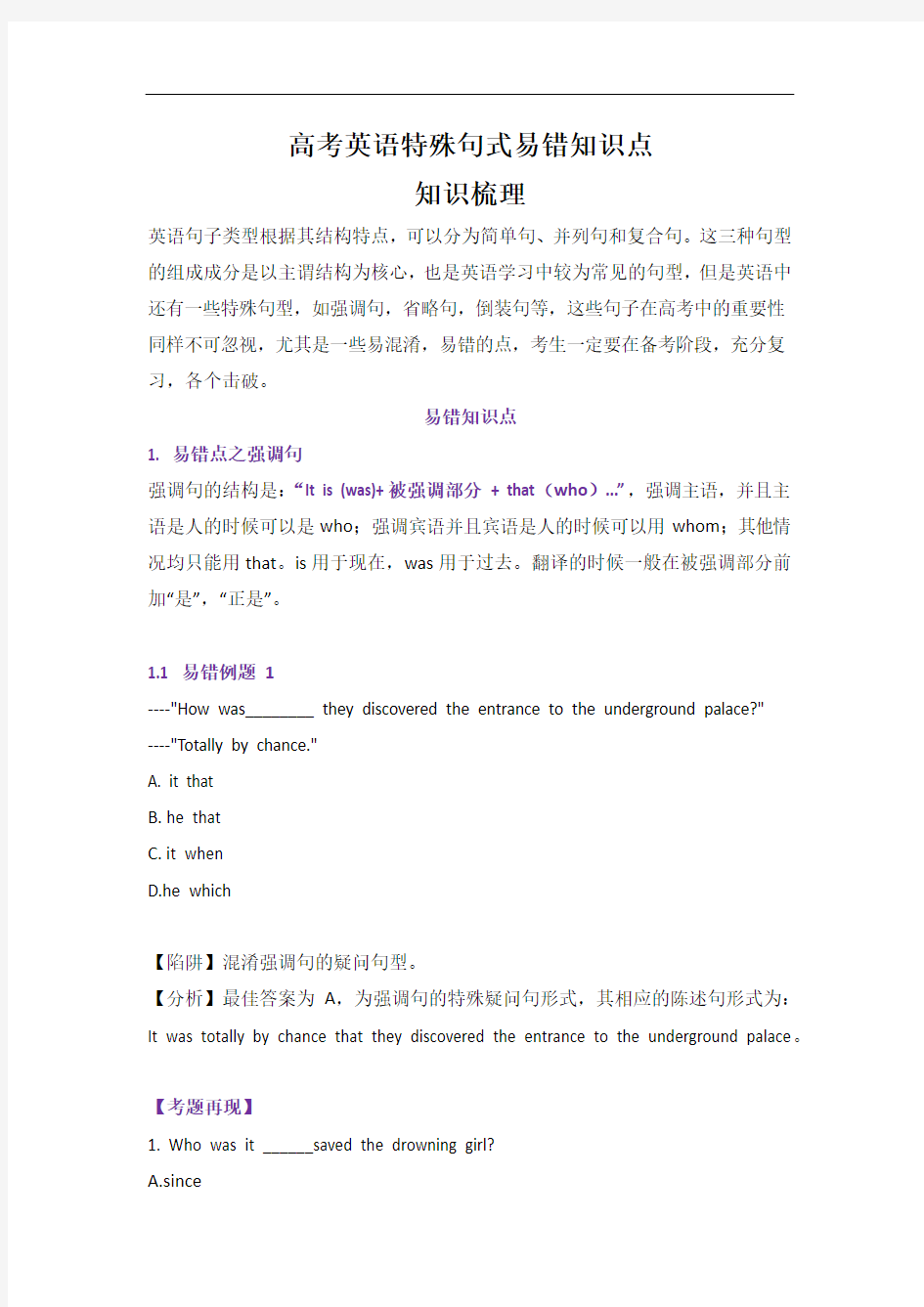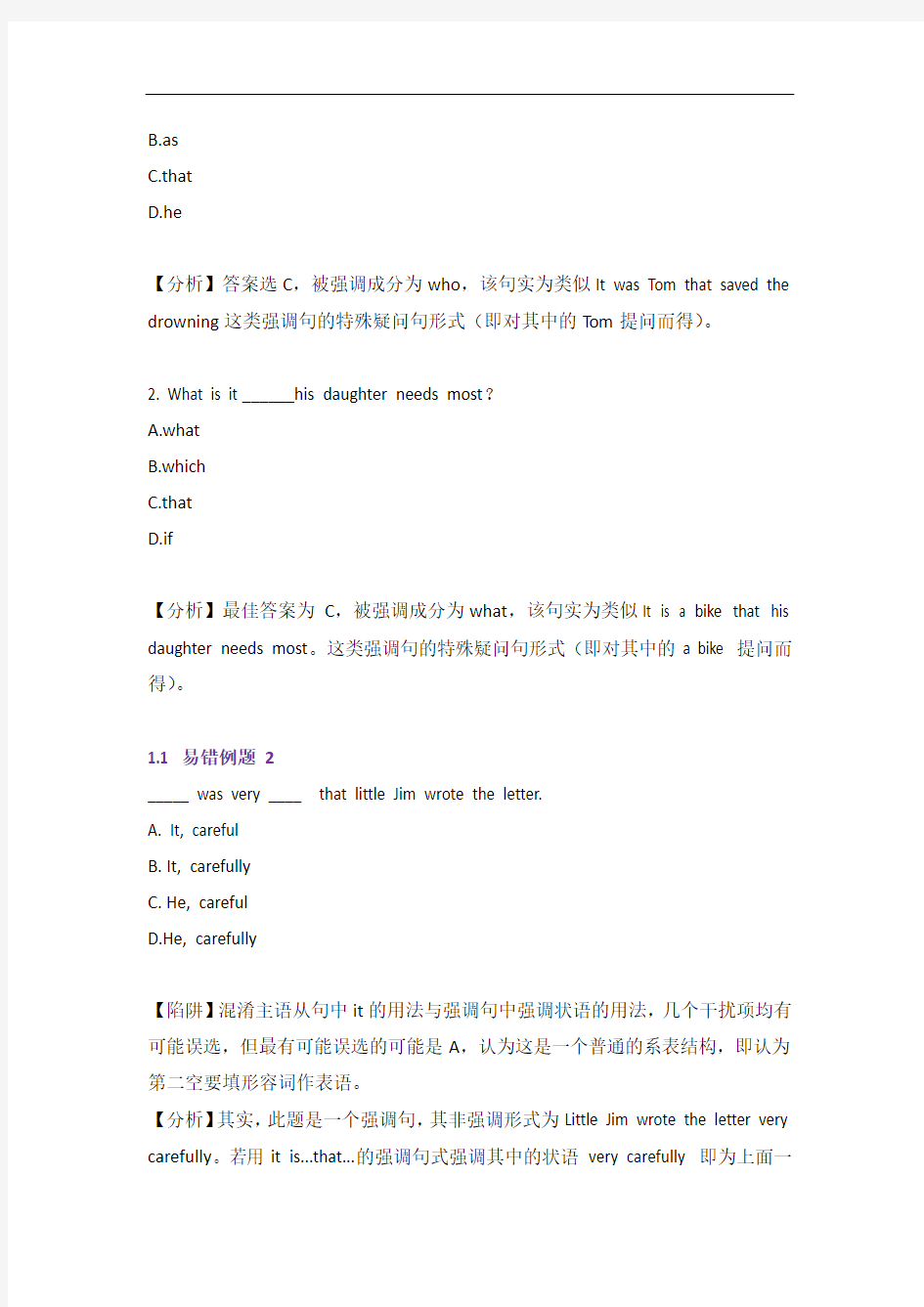

高考英语特殊句式易错知识点
知识梳理
英语句子类型根据其结构特点,可以分为简单句、并列句和复合句。这三种句型的组成成分是以主谓结构为核心,也是英语学习中较为常见的句型,但是英语中还有一些特殊句型,如强调句,省略句,倒装句等,这些句子在高考中的重要性同样不可忽视,尤其是一些易混淆,易错的点,考生一定要在备考阶段,充分复习,各个击破。
易错知识点
1. 易错点之强调句
强调句的结构是:“It is (was)+被强调部分+ that(who)...”,强调主语,并且主语是人的时候可以是who;强调宾语并且宾语是人的时候可以用whom;其他情况均只能用that。is用于现在,was用于过去。翻译的时候一般在被强调部分前加“是”,“正是”。
1.1 易错例题1
----"How was________ they discovered the entrance to the underground palace?"
----"Totally by chance."
A. it that
B.he that
C.it when
D.he which
【陷阱】混淆强调句的疑问句型。
【分析】最佳答案为A,为强调句的特殊疑问句形式,其相应的陈述句形式为:It was totally by chance that they discovered the entrance to the underground palace。
【考题再现】
1. Who was it ______saved the drowning girl?
A.since
B.as
C.that
D.he
【分析】答案选C,被强调成分为who,该句实为类似It was Tom that saved the drowning这类强调句的特殊疑问句形式(即对其中的Tom提问而得)。
2. What is it______his daughter needs most?
A.what
B.which
C.that
D.if
【分析】最佳答案为C,被强调成分为what,该句实为类似It is a bike that his daughter needs most。这类强调句的特殊疑问句形式(即对其中的a bike 提问而得)。
1.1 易错例题2
_____ was very ____ that little Jim wrote the letter.
A. It, careful
B.It, carefully
C.He, careful
D.He, carefully
【陷阱】混淆主语从句中it的用法与强调句中强调状语的用法,几个干扰项均有可能误选,但最有可能误选的可能是A,认为这是一个普通的系表结构,即认为第二空要填形容词作表语。
【分析】其实,此题是一个强调句,其非强调形式为Little Jim wrote the letter very carefully。若用it is...that...的强调句式强调其中的状语very carefully 即为上面一
题的题干。要注意的是,这里不是it做形式主语的主语从句,因为将后面的从句放在句首,句子是不成立的。
【考题再现】
1. It was when she was about to go to bed the telephone rang.
A.since
B.as
C.that
D.then
【分析】答案选C,被强调成分为when she was about to go to这一时间状语从句
2. It may have been at Christmas_______ John gave Mary a handbag.
A.before
B.who
C.that
D.when
【分析】答案选C,被强调成分为at Christmas其中的动词be采用了may have been 这一较为复杂的形式。
1.1 易错例题3
----"Where did you find the professor who made the speech yesterday?"
----"It was in the hall ______ the students often have a meeting."
A. where
B. which
C. that
D. when
【陷阱】混淆强调句与定语从句。很可能误选C,认为这是一个强调句,强调地点状语in the hall。
【分析】假若选C,即有It was in the hall that the students often have a meeting 该句的意思是“学生们通常是在大厅开会”,单独看这一句,无论是其意思还是其语法均未错,但若将其与上文联系起来看,则不通,因为上文的意思是“你是在哪儿找到昨天作报告的那位教授的?”假若将答句改为It was in the hall that I found the professors完全可以。其实,此题的最佳答案是A,where the students often have a meeting定语从句,用以修饰其前的名词the hall句意为“是在学生们经常开会的那个大厅(找到教授的)”,这样语意就通顺了。所以这里不是强调句。
【考题再现】
It was in the small house ____ was built with stones by his father ____ he spent his childhood.
A. which, that
B. that, which
C. which, which
D. that, where
【陷阱】混淆强调句与定语从句。几个干扰项均有可能误选,主要是分不清为强调句型,或即使分清为强调句型,也分不清强调哪一个成分。
【分析】答案选A,第一空填which,用以引导定语从句;第二空填that,为强调句的结构词,被强调部分为in the small house以及修饰它的定语从句which was built with stones by his father此题难就难在强调句型中套用了定语从句。
【考题拓展】
Was it five o' clock_______ the fire broke out?
A. when
B. that
C. which
【陷阱】混淆强调句与状语从句。容易误选B,误认为这是强调句。
【分析】其实,此题应选A,这不是强调句。因为在强调句中,若去掉强调句的结构词it is/was that..,句子结构仍然完整,但此句不是这样,若去掉结构词,即为Five o'clock the fire broke out句子不完整,但若在five o'clock前加上介词at则可以,因为at five o'clock用作时间状语。此题选A可分析为:it表时间,when the fire broke ou时间状语从句,全句意为“火灾是5点钟发生的吗?”
2. 易错点之省略句
对省略现象的考查已成为近年来英语高考试题中的常考点。因为省略这种语法手段既可避免重复,突出新的信息,又能使上下文更紧密地连接起来。
2.1 易错例题1
----Have you got any particular plans for the coming holiday?
----Yes_____.I'm going to visit some homes for the old in the city.
A. If ever
B. If busy
C.If anything
D.If possible
【陷阱】容易误选A项,考生没有掌握常用的省略句式。
【分析】最佳答案为D。本题考查条件状语从句中的省略现象,if possible是省略句,完整的句子是:If it is possible。
【考题再现】
----"What were you trying to prove to the police?"
----"______ I was last night."
A.That
B.When
D. What
【陷阱】其余三项均有可能误选,考生不知道这里是从句的省略。
【分析】此题应选C,其完整形式为:I was trying to prove to the police where I was last night.(where引导的是一个宾语从句)。
【点睛】
在when,while,if,as if,though,as,until,once,whether,unless,where 等连词连接的时间、条件、方式、让步、地点等状语从句中,常省略跟主句相同的主语和be动词。
?When ( water is) pure, water is a colorless liquid.
水纯净时,是无色的液体。
? Errors, if (there are ) any, should be corrected.
如果有什么错误,就应当被改正。(完整句中,虽然不是error,但是代词代指的就是error。)
? If ( it is ) necessary, we'11 have a meeting.
如果必要,我们开个会。(完整句中,虽然不是we will,但是代词it 代指的就是这件事。)
2.1 易错例题2
What would have happened___________ , as far as the river bank?
A. Bob had walked farther
B. if Bob should walk farther
C. had Bob walked farther
D. if Bob walked farther
【陷阱】容易误选B项,考生没有掌握与过去事实相反的虚拟条件句的倒装句型。
【分析】最佳答案为C。根据主句的谓语动词would have happened,可以断定要用虚拟语气。句子意思是:如果鲍勃走得远一点,走到岸边,会发生什么事呢?【点睛】
若在虚拟条件句中含有were,had或should,可以省略if,但是其余成分要部分倒装,即将were,had或should移至句首。
? Should the teacher come, she could answer all the questions.
老师如果来的话,她会回答所有的问题。
? Were it not for the sun (=If it were not for the sun), nothing could exist on the earth.
如果没有太阳,世界上将什么都不存在。
?Had they not helped us ( = If they had not helped us), we wouldn't have succeeded.
如果没有他们的帮助,我们就不会成功。
3. 易错点之倒装句
英语最基本的语序是主语在前,谓语动词在后。但有时由于句子结构的需要或表示强调,就要采用倒装形式。倒装分两种情况:
★将谓语动词完全移到主语之前称为完全倒装;
★只将助动词或情态动词放到主语之前称为部分倒装。
并且强调性倒装和以so,neither,nor开头的句子倒装是高考的热点。
3.1 易错例题1
Only in this way______make progress in your English.
A. you
B. can you
C. you are able to
D. will you able to
【陷阱】误选C。考生对部分倒装的句型不够熟悉。
【分析】最佳答案B。题干是一个由only强调方式状语的句子,这个结构要用倒装。句意为:只有用这种方法,你的英语才会有进步。但是要注意,并不是所有含only或者only位于句首的句子都需要倒装。如:Only a few young men went to the theater. 这个句子only强调的是主语,而不是状语,那么这种句子就不需要倒装。换言之,只有当only修饰状语的时候,句子才需要用部分倒装。
【点睛】使用部分倒装的句型包括:
★在疑问句中。如:
Is she singing in the classroom?
What does your mother do?
★用在以so,nor,neither开头,表示谓语所述的情况也适用于另一个人或一事物的肯定或否定句中。so用于肯定句,表示“也一样”“也这样”;nor,neither 用于否定句,表示“同样也不,也不这样”。如:
I am watching TV. So is she.
My parents didn't watch TV last night. Neither(Nor) did I.
He can't speak any foreign language. Nor can his father.
注意:
1. 表示两人的同样一个情况时,只能表示一件事,即上、下句所使用的动词、时态要一致。否则要用so it is with… ,如:His uncle is a worker and has been working in the factory for more than ten years. So it is with his aunt.(两件事是一样的:是工人+在工厂工作超过10年)
2. 当so引出的句子用以对上文内容加以证实或肯定时,不可用倒装结构。意为“的确如此”。
如:---It's raining hard. 雨下得真大。
---So it is. 确实是的。
★在以hardly (scarcely),never,not,little,few,seldom,nowhere,no,no-等否定或半否定意义的副词、连词放在句首时要用倒装句,采用部分倒装。但是如果不放在句首就不要倒装。
Little did he say at the meeting.
Never shall I forget the day when I joined the Army.
Not once did we visit the city of our own.
Seldom in all my life have I met such a determined person.
Never have I seen such a performance.
Nowhere will you find the answer to this question.
★用于以only所修饰的副词、介词短语或状语从句的句子中。
Only when the war was over in 1918 was he able to get happily back to work.
Only in this way can we learn English well.
注意:如果only后的词组不是状语,不需倒装。如:Only Wang Lili knows this.(only 修饰主语时则不用倒装)
★在虚拟结构中,条件从句的谓语含有were,had 和should这三个词是,可省去if,将这些词移至主语之前。
Had I time (= If I had time), I would go and help you.
Were I you (= If I were you), I would go abroad.
Should he come (=If he should come), tell him to ring me up.
★as/though引导让步状语从句时要倒装(形容词/ 副词/ 名词/ 动词+ as + 主语+ 谓语)。
Proud as they are, they are afraid to see me.
Child as he is, he seems to know everything.(child前不加冠词)
Hard as he worded, he made little progress.
Much as she likes him, she doesn't love him.
★用于某些表示祝愿的句子里。
May you succeed!
Long live the People's Republic of China!
★So + 形容词、副词及such 置于句首时要倒装。
So happy did he feel.
Such was me.
Such a good girl is she.
Such delicious food did he cook.
★固定搭配hardly...when,scarcely...when...,no sooner...than... 可以用正常语序had hardly done when... did 或用倒装句式Hardly had + 主语+ done when (i)
句式。hardly所在的句子用过去完成时。(主倒从不倒)
Hardly(Scarcely) had he reached the station when the train started.
The bell hardly had rung when the class began. = Hardly had the bell rung when the class began.
No sooner had he arrived in Beijing than he began to work.
★not only ... but also引出的并列句,紧跟not only后的句子要倒装,but also后的句子不倒装。注意:如果否定词not only不在句首,那么就不倒装。
Not only did he refuse the gift, he also severely criticized the sender.
Not only was there no electricity, but also no water.
如果置于句首的Not only… but also仅连接两个并列词语,不可用倒装结构。如:Not only you but also I am fond of music.
★当not until引出主从复合句,主句倒装,从句不倒装。注意:如否定词不在句首不倒装。
Not until the child fell asleep did the mother leave the room.
★频度副词及短语often,always,now and then,many a time,every other day 等放在句首时,有时也倒装。
Many a time has he come to comfort me.
3.1 易错例题2
Then _______ a new development that had far-reaching effects.
https://www.doczj.com/doc/a812118756.html,e
https://www.doczj.com/doc/a812118756.html,ing
C.came
D.had come
【陷阱】误选B。考生看到这种动词开头的,总是先入为主的误以为这是考查动名词短语做主语。
【分析】答案选C,句子为时间副词then 置于句首的倒装句,came为句子谓语。注:这类倒装句的谓语通常是go,come,follow,exist,remain等不及物动词。? Then followed a great noise.接着传来一阵巨响。
? Then came the day of his examination. 接着就是他参加考试的日子。
【点睛】使用完全倒装的句型包括:
★在“there be”结构里,there是引导词,主语在be后。在“there + be”结构中的谓语动词有时不用be,而用表示类似“存在”观念的其他不及物动词。如:live,stand,come,lie,flow,enter,rise 和appear等。
There is a box on the table.
There came shouts for help from the river.
There lies a large wheat field in front of the house.
Many years ago there lived an old man in the wooden house.
★为了表达生动,有时把表地点、方位的副词,如here,there,now,then,thus,up,down,out,off,over,away,in等放在句首,同时把谓语动词放在
主语之前,在here,there等副词开头的某些句子里(要用一般现在时态)。若主语为人称代词,主语和谓语动词的位置不变,只将副词放在句首。(完全倒装)There goes the bell.
Here is an apple for you.
There she comes. (人称代词倒装)
Away hurried the boy.
Out rushed the girl.
★为了保持句子的平衡或为了强调表语和状语,或使上下文紧密衔接,常把表示地点的介词短语(如on the wall,under the tree,in front of the house,in the middle of the room等)放在句首用时,要用完全倒装,该结构不需加助动词。
构成: 1) 表(介短)+系+主
2) 状(介短)+谓动+主
On the top of the hill stands a pine tree.
In front of the classroom is a playground.
East of the town lies a beautiful lake.
★“表语(代词such) + be + 主语”结构。
Such was the story he told me.
Such were her words.
Such was the result.